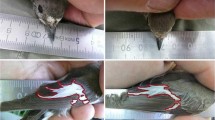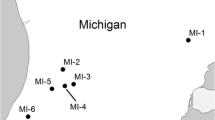Summary
We examined associations among parasite infections, secondary sexual traits and testosterone in male red-winged blackbirds sampled at the start of the breeding season. Parasites quantified included ectoparasitic lice and mites and endoparasitic blood protozoans, nematodes, trematodes and cestodes. Secondary sexual traits that we quantified included body size, epaulet size and color, song repertoire size and song switching rate, and behavioral responses to male and female models. Overall we found few significant associations between parasites and secondary sexual traits, between secondary sexual traits and testosterone, or between parasites and testosterone. In addition, most parasite taxa appeared to infect birds independently, although the low prevalence (<50%) of many of the parasites meant that our sample sizes were too small to detect weak associations. Our most promising results were obtained for ectoparasitic mites, which tended to occur on birds uninfected with other parasites, on birds with longer epaulets, and on birds with higher levels of testosterone. Epaulet length and testosterone are both probable correlates of dominance in this species. Further research will be required to determine whether there is a causal link between the immunosuppressive effects of testosterone and the mite infections, and between testosterone, epaulet length and male mating success.
Similar content being viewed by others
References
Balmford A, Read AF (1991) Testing alternative models of sexual selection. Trends Ecol Evol 6:274–276
Beletsky LD, Orians GH (1989) Territoriality among red-winged blackbirds III. Testing hypotheses of territorial dominance. Behav Ecol Sociobiol 24:333–339
Beletsky LD, Orians GH, Wingfield JC (1989) Steroid hormones and polygyny: relationships to territorial staus, breeding experience, and reproductive success in male red-winged blackbirds. Auk 106:107–117
Bennett GF (1970) Simple techniques for making avian blood smears. Can J Zool 48:585–586
Borgia G (1986) Satin bowerbird parasites: a test of the bright male hypothesis. Behav Ecol Sociobiol 19:355–358
Burley N, Tidemann SC, Halupka K (1991) Bill colour and parasite levels in zebra finches. In: Loye JE, Zuk M (ed) Bird-parasite interactions. Oxford University Press, Oxford, pp 359–376
Clayton DH (1991) The influence of parasites on host sexual selection. Parasitol Today 7:329–334
Eckert CG, Weatherhead PJ (1987a) Owners, floaters and competitive asymmetries among territorial red-winged blackbirds. Anim Behav 35:1317–1323
Eckert CG, Weatherhead PJ (1987b) Ideal dominance distributions: a test using using red-winged blackbirds. Behav Ecol Sociobiol 20:43–52
Eckert CG, Weatherhead PJ (1987c) Competition for territories in red-winged blackbirds: Is resource-holding potential realized? Behav Ecol Sociobiol 20:369–375
Eckert CG, Weatherhead PJ (1987d) Male characteristics, parental quality and the study of mate choice in red-winged blackbirds. Behav Ecol Sociobiol 20:35–42
Folstad I, Karter AJ (1992) Parasites, bright males, and the immunocompetence handicap. Am Nat 139:603–622
Garnham PCC (1966) Malaria parasites and other haemosporidia. Blackwell Scientific, Oxford
Hamilton WD, Zuk M (1982) Heritable true fitness and bright birds: a role for parasites? Science 219:384–387
Harding CH, Follett BK (1979) Hormone changes triggered by aggression in a natural population of blackbirds. Science 203:918–920
Hood DE, Welch HE (1980) A seasonal study of the parasites of the red-winged blackbird (Agelaius phoeniceus L.) in Manitoba and Arkansas. Can J Zool 58:528–537
Kirkpatrick CE, Robinson SK, Kitron UD (1991) Phenotypic correlates of blood parasitism in the common grackle. In: Loye JE, Zuk M (ed) Bird-parasite interactions. Oxford University Press, Oxford, pp 349–358
Metz KJ, Weatherhead PJ (1991) Color bands function as secondary sexual traits in red-winged blackbirds. Behav Ecol Sociobiol 28:23–27
Møller AP (1991) Parasites, sexual ornaments, and mate choice in the barn swallow. In: Loye JE, Zuk M (ed) Bird-parasite interactions. Oxford University Press, Oxford, pp 328–348
Møller AP (1992) Female swallow preference for symmetrical male sexual ornaments. Nature 357:238–240
Moore MC, Kranz R (1983) Evidence for androgen independence of male mounting behavior in white-crowned sparrows (Zonotrichia leucophrys gambelii). Hormon Behav 17:414–423
Orians GH, Beletsky LD (1989) Red-winged blackbird. In: Newton I (ed) Lifetime reproduction in birds. Academic Press, New York, pp 183–197
Read AF (1990) Parasites and the evolution of host sexual behaviour. In: Barnard CJ, Behnke JM (ed) Parasitism and host behaviour. Taylor and Francis, London, pp 117–157
Read AF, Harvey PH (1989) Reassessment of comparative evidence for Hamilton and Zuk hypothesis on the evolution of secondary sexual characters. Nature 339:618–620
Schall JJ (1990) The ecology of lizard malaria. Parasitol Today 6:264–269
Searcy WA (1979) Morphological correlates of dominance in captive male red-winged blackbirds. Condor 81:417–420
Searcy WA, Yasukawa K (1990) Use of the song repertoire in intersexual and intrasexual contexts by male red-winged blackbirds. Behav Ecol Sociobiol 27:123–128
Shutler D, Weatherhead PJ (1990) Targets of sexual selection: song and plumage of wood warblers. Evolution 44:1967–1977
Shutler D, Weatherhead PJ (1991a) Owner and floater red-winged blackbirds: determinants of status. Behav Ecol Sociobiol 28:235–241
Shutler D, Weatherhead PJ (1991b) Basal song rate variation in red-winged blackbirds: sound and fury signifying nothing?Behav Ecol 2:133–142
Shutler D, Weatherhead PJ (1992) Surplus territory contenders in male red-winged blackbirds: where are the desperados? Behav Ecol Sociobiol 31:97–106
Smith DG, Reid FA (1979) Roles of the song repertoire in redwinged blackbirds. Behav Ecol Sociobiol 5:279–290
Smithe FB (1975) Naturalist's color guide. American Museum of Natural History, New York
Weatherhead PJ (1990) Secondary sexual traits, parasites, and polygyny in red-winged blackbirds, Agelaius phoeniceus. Behav Ecol 1:125–130
Weatherhead PJ, Bennett GF (1991) Ecology of red-winged blackbird parasitism by haematozoa. Can J Zool 69:2352–2359
Weatherhead PJ, Bennett GF (1992) Ecology of haematozoa parasitism in brown-headed cowbirds. Can J Zool 70:1–7
Weatherhead PJ, Bennett GF, Shutter D (1990) Sexual selection and parasites in wood warblers. Auk 108:147–152
Wheeler TA, Threlfall W (1986) Observations of the ectoparasites of some Newfoundland passerines (Aves: Passeriformes). Can J Zool 64:630–636
Wingfield JC, Smith JP, Farner DS (1982) Endocrine responses of white-crowned sparrows to environmental stress. Condor 84:399–409
Wingfield JC, Hegner RE, Dufty AM Jr, Ball GF (1990) The “challenge hypothesis”: theoretical implications for patterns of testosterone secretion, mating systems, and breeding strategies. Am Nat 136:829–846
Yasukawa K (1981) Song repertoires in the red-winged blackbird (Agelaius phoeniceus): a test of the Beau Geste hypothesis. Anim Behav 29:114–125
Zuk M (1990) Reproductive strategies and disease susceptibility: an evolutionary viewpoint. Parasitol Today 6:231–233
Zuk M (1991) Parasites and bright birds: new data and a new prediction. In: Loye JE, Zuk M (ed) Bird-parasite interactions. Oxford University Press, Oxford, pp 319–327
Author information
Authors and Affiliations
Additional information
Correspondence to: P. Weatherhead
Rights and permissions
About this article
Cite this article
Weatherhead, P.J., Metz, K.J., Bennett, G.F. et al. Parasite faunas, testosterone and secondary sexual traits in male red-winged blackbirds. Behav Ecol Sociobiol 33, 13–23 (1993). https://doi.org/10.1007/BF00164342
Received:
Accepted:
Issue Date:
DOI: https://doi.org/10.1007/BF00164342




